|
Begrafenis /Burial - Waasten - 04/07/2007
Hieronder een aantal foto's van de begrafenis van 3 Britse
soldaten op woensdag 4 juli 2007 op de Britse militaire begraafplaats
Prowse
Point in Waasten.
Meer dan 90 jaar nadat hij sneuvelde werd Private Richard
Lancaster van het 2nd Battalion The Lancashire Fusiliers
herbegraven op Prowse Point Cemetery.
Private Lancaster werd in Lancashire geboren in 1882. Hij
deed dienst in de Regular Army van 1901 tot 1905, wanneer
hij huwde met Phoebe Porter in Burnley. Beide waren wevers.
Hij werd in augustus 1914 gemobiliseerd en vocht bij Le Cateau
en Armentičres. Op 10 november 1914 werd hij gedood tijdens
een tegenaanval in de omgeving van Ploegsteertbos. Zijn stoffelijke
resten werden door archeologen ontdekt in 2006, samen met
twee niet-geďdentificeerden.
FOUR FIRST WORLD WAR SOLDIERS RE-INTERRED
Over 90 years after he was killed in action, Private Richard
Lancaster of The 2nd Battalion The Lancashire Fusiliers, was
re-interred at Prowse
Point Commonwealth War Graves Cemetery in Belgium on Wednesday,
4th July. The service started at 1000hrs.
Pte Lancaster was born in Lancashire in 1882; he served in
the Regular Army from 1901-05, when he married Phoebe Porter
in Burnley. The marriage certificate lists them both as weavers.
He was mobilised in August 1914 and embarked for France, where
he sawaction at Le Cateau and Armentières. He was killed
in action on 1st November 1914 during a counter-attack south
of leper (Ypres), near Ploegsteert Wood, only a few hundred
yards from where the Christmas Truce would take place a month
later. pte Lancaster's remains were discovered by archaeologists
in 2006 alongside two unknown soldiers who will be re-interred
during the same ceremony.
The service on 4th July was attended by pte Lancaster's grand-daughter
and other family members. The Honour Guard and Buglers will
be found by 1st Battalion The Royal Regiment of Fusiliers
who will accord pte Lancaster and his comrades full military
honours.
There was a further service at 1400hrs at Tyne Cot Commonwealth
War Graves Cemetery, where the remains of an unknown Lancashire
Fusilier were re-interred. These were found in May 2005 during
archaeological excavations on the former Ypres-Roulers railway,
300m from Tyne Cot cemetery. On 9 October 1917 six battalions
of the Lancashire Fusiliers took part in a final push to take
the railway and the ridge at Poelkapelle. 307 men were killed
in action; 247 ofthem have no known grave and are commemorated
on the rear wall of the cemetery.
After this ceremony the Memorial Museum Passchendaele 1917
unveiled a plaque on the spot where he was found and where
a preserved section of the wartime railway has been restored.
This now forms part of a walking and cycle path.
The re-interment came eight days before the state ceremony
to mark the 90th anniversary of the Battie of Passchendaele,
also at Tyne Cot Commonwealth War Graves Cemetery.
PRIVATE RICHARD LANCASTER
2ND BATTALION THE LANCASHIRE FUSILIERS KILLED IN ACTION ON
10TH NOVEMBER 1914
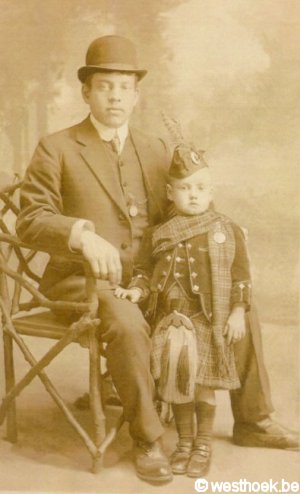
Private Richard Lancaster of the 2nd Battalion the Lancashire
Fusiliers was killed during a night attack on the 10th November
1914. He left a wife, Phoebe and four children - Richard,
William, Rimmer and John.
Born in Lancashire in 1882, Richard Lancaster enlisted into
the Regular Army on the 1 st March 1901, and served for nearly
four years. He left regular service for the reserve in January
1905 and in September of that year he married Phoebe Porter
in Burnley. On the marriage certificate they are both listed
as weavers.
Following German threats to neutral Belgium, at 4pm on the
4th August 1914, the British Government gave the order for
mobilisation. The order was received at the Depot of the Lancashire
Fusiliers in Bury at 6pm on that day. Of the 1,752 reservists
on the books, 1,454, including Richard Lancaster, reported
to the Depot the next day. At the Depot he underwent a medical
inspection and was issued with his rifle, c10thing and equipment
and despatched to the 2nd Battalion stationed at the Citadel
Barracks in Dover. Although he was issued with the new compressed
fibre identity disks as a reservist he had a pre-war metal
identity disk. Luckily he kept the metal identity disk that
survived while the compressed fibre disks rotted away. The
metal disk, stamped 8372 Lancaster R was found by archaeologists
in 2006 and assisted in the identification of the remains.
The 2nd Battalion formed part of the 1 ih Infantry Brigade
itself part of the 4th Division. Initially the division was
ordered to cover the deployment of the .British Expeditionary
Force (BEF) to France and so at 3am on the fourth day of mobilisation
the 2nd Battalion and Richard Lancaster left Dover by train
for Cromer. On the 21 st the Battalion embarked for France
landing at Boulogne on the 23rd August. The 'Old Contemptibles'
were regular soldiers or reservists who had served pre-war
in the professional British Army and who became the first
British soldiers to be sent into France at the beginning of
WW1. The name came from a comment made by Kaiser Wil helm
II in the Order of the Day for 19th August 1914 where he encouraged
his troops to defeat 'that contemptible little army'.
The first taste of action for the 2nd Battalion and Richard
was at Le Cateau. This was rapidly followed bya retreat in
the face of overwhelming force. Over a period of 12 days Richard
Lancaster marched 146 miles at an average of 12 miles a day
concluding with actions at the Marne and on the Aisne.
Eventually room to manoeuvre ran out and both sides settled
into trench warfare. By November 1914 following the Battie
of Armentières, Richard and the battalion found themselves
occupying positions to the south of Ypres on the eastern edge
of Ploegsteert Wood. It should be noted that the soldiers
had difficulty with the local spelling and pronunciation and
the name rapidly changed to Plugstreet Wood.
On the th November the Germans broke into the wood and were
reinforced by a further German attack on the night of the
9th/10th. Richard Lancaster and The Lancashire Fusiliers were
ordered to support the Argyll and Sutherland Highlanders in
a night counter-attack. In the darkness the situation became
confused and men became separated. The War Diary reports that
the Lancashire Fusiliers seized one trench and a farm occupied
by the enemy and bayoneted the occupants. Unfortunately the
trench and farm were covered by fire from other German positions
and were abandoned. Nevertheless further German advances into
the wood were stopped for the rest of the war.
Richard Lancaster and four of his comrades were killed that
night and buried hastily close to the front line; they lay
undiscovered for 90 years. In 2001 the body of Harry Wilkinson
was discovered close to the site of the original action in
1914. In 2006 archaeologists discovered the remains of Richard
Lancaster's body only a few metres away. The remains of Privates
Brown, Robinson and Sheridan, killed in action on the same
night, remain to be found.
"OMNIA AUDAX"

The Island
of Peace and the Church at Messines.
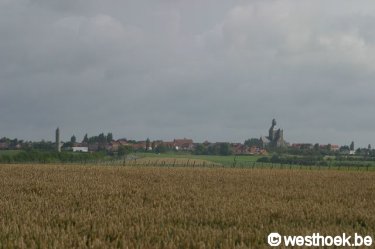
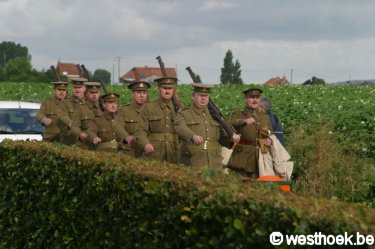
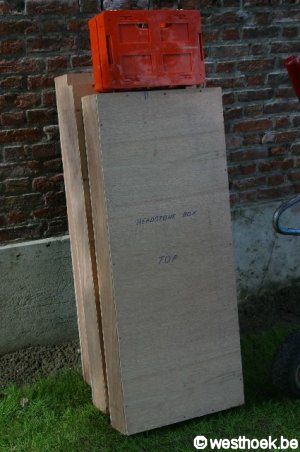
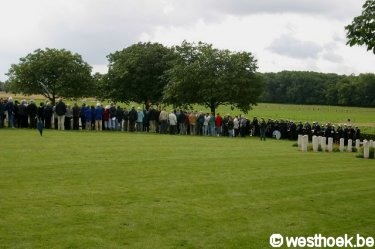
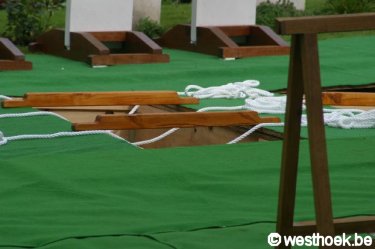
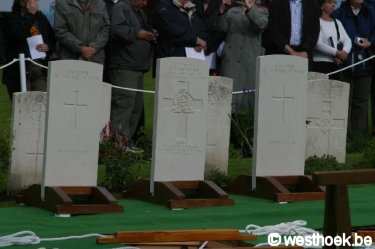
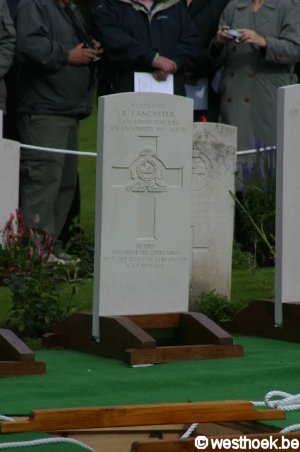



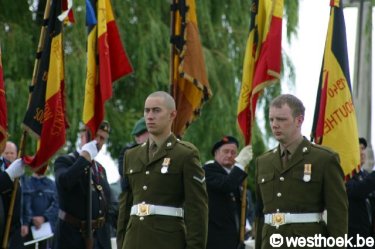



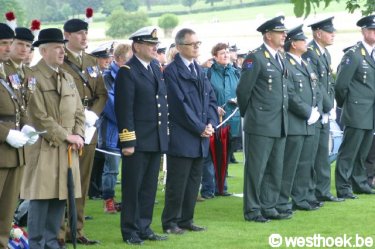

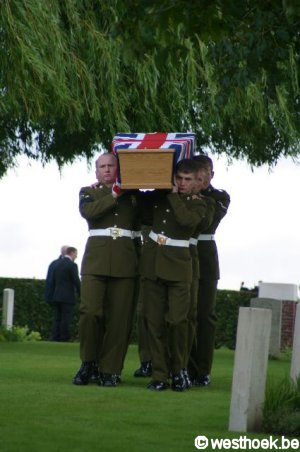
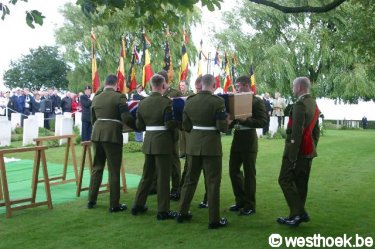
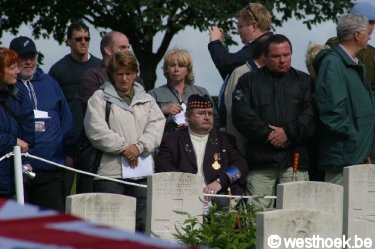

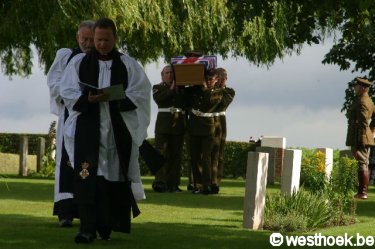

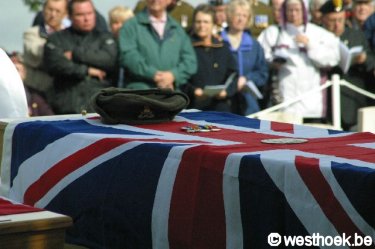




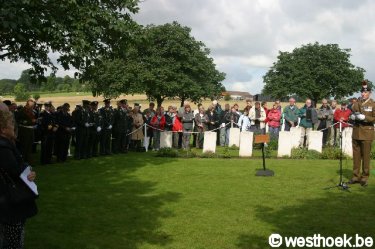
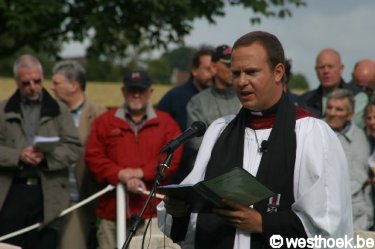
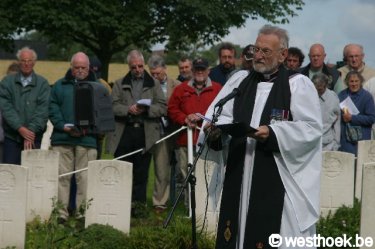

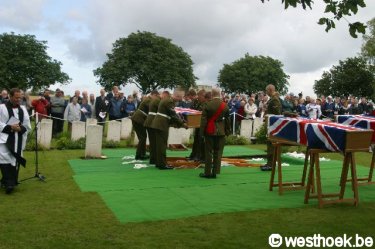



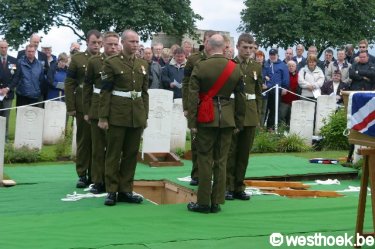
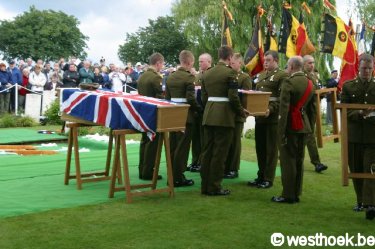
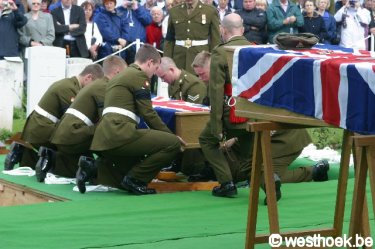
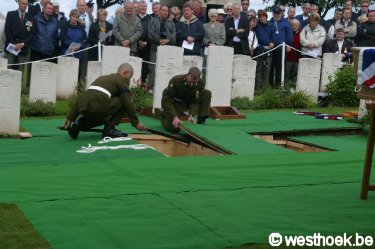

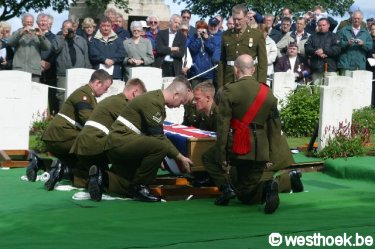

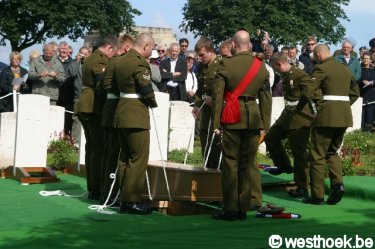
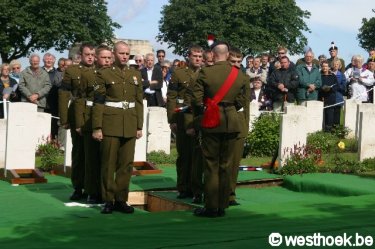
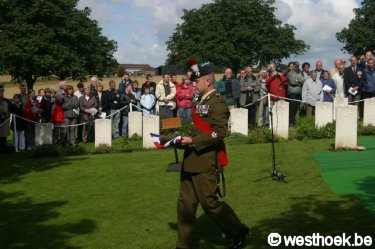
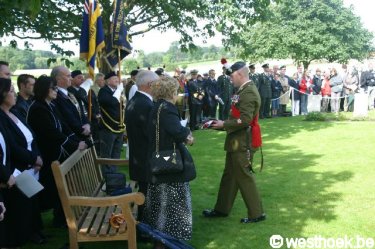

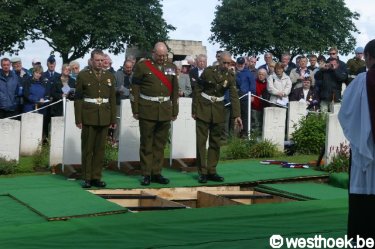
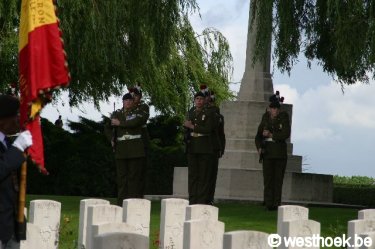
Last Post
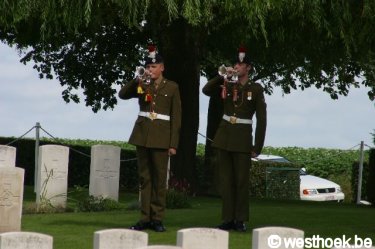
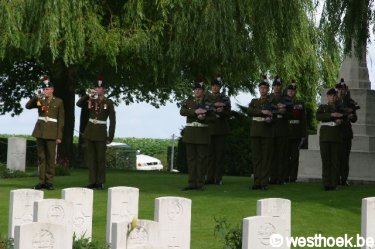
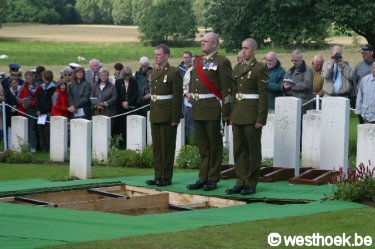
Wreath laying.
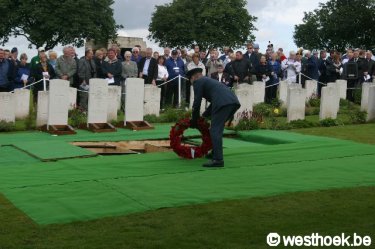

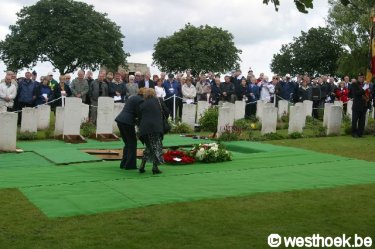
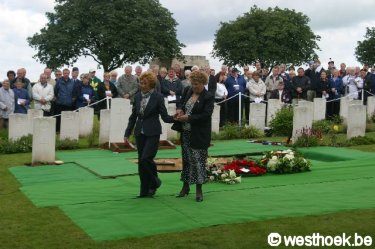
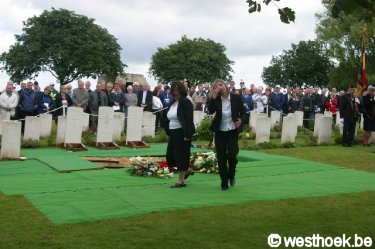

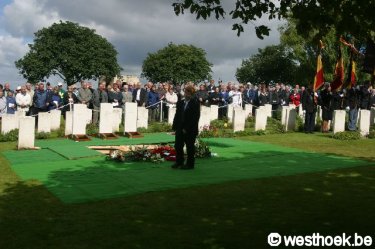
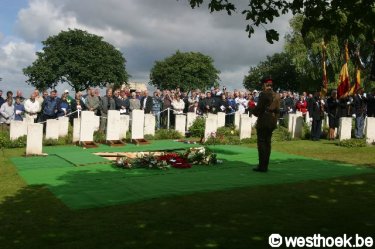
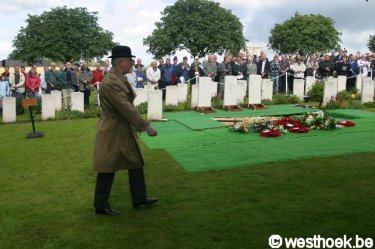
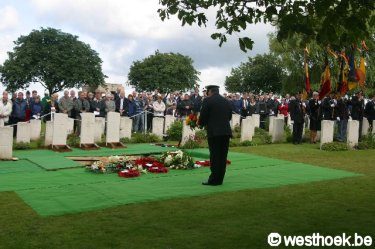
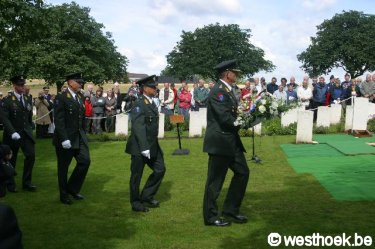
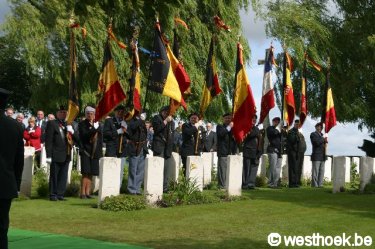


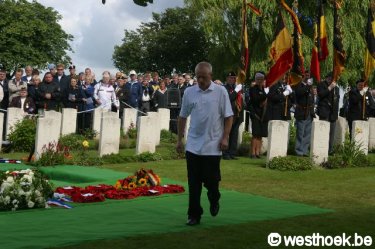

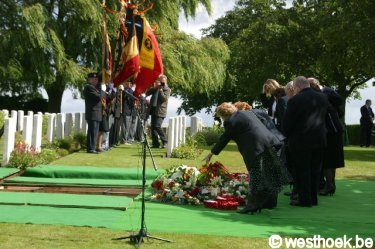
The information panels at the entry of the cemetery.
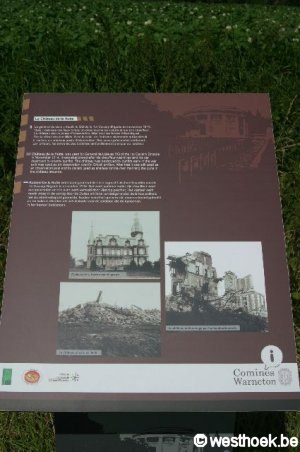
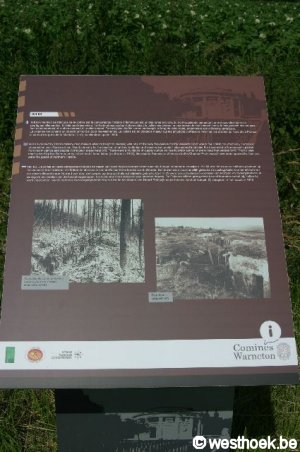
Deze rubriek staat open voor iedereen.
Ook jij kunt foto's doorsturen voor de rubriek "Je was er
bij". Ons adres: info@westhoek.be
Everyone can send pictures for these pages "You were
there". Our address: info@westhoek.be
|